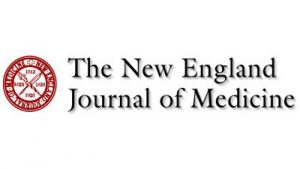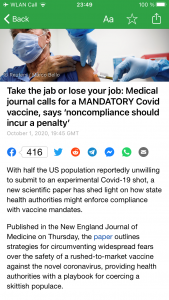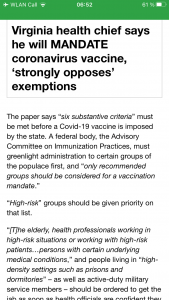Ensuring Uptake of Vaccines against SARS-CoV-2
by
Mello et al. wrote the following in the New England Medical Journal of Medicine (NEJM) published online on October 1st, 2020. (This article was published earlier on June 26, 2020, at NEJM.org. but appeared online on October 1st, 2020.
October 1st, 2020
COVID-19 (SARS-CoV-2) continues to present a heavy toll and the development of a vaccine appears the most promising means of restoring normalcy to civil life. Perhaps no scientific breakthrough is more eagerly anticipated. But bringing a vaccine to the market is only half the challenge; also critical is ensuring a high enough vaccination rate to achieve herd immunity. Concerningly, a recent poll found that only 49% of Americans planned to get vaccinated against SARS-CoV-2.(1)

One option for increasing vaccine uptake is to require it. Mandatory vaccination has proven effective in ensuring high childhood immunization rates in many high-income countries. However, except for influenza vaccination of health care workers, mandates have not yet been widely used for adults.
Although a vaccine remains months to years away, developing a policy strategy to ensure uptake takes time. Already today the authorities must develop a strategy to help ensuring uptake by the general population of the vaccine when it becomes available — including consideration of when a mandate might become appropriate. Our approach is guided by lessons from U.S. experiences with vaccines for the 1976 “swine flu,” H1N1 influenza, smallpox, and human papillomavirus (HPV).
Mello et al. propose that six substantive criteria should be met before country imposes a SARS-CoV-2 vaccine mandate (see box).
The first is the existence of evidence that Covid-19 is inadequately controlled by national authorities by other measures, such as testing, contact tracing, and isolation and quarantine — as indicated by sustained, troubling trends in new cases, hospitalizations, or deaths. Principles of public health law and ethics require that interventions that impinge on autonomy be reasonable and necessary; therefore, COVID-19 must present an ongoing threat. By the time a vaccine is available more will be known about natural immunity in the population, the consequences of relaxing community mitigation measures, and the feasibility of scaling up test-and-trace strategies. There should be a reasonable indication as to whether further and stricter measures are needed.
Six Criteria for Mandatory Vaccinations on a National (Global?) Scale for COVID-19 and Other Future Epidemics
-
Covid-19 is not adequately contained in a country or globally;
-
National health authorities must determine which risk groups must be vaccinated or the country at large;
-
The supply of vaccine(s) must be sufficient to cover the risk groups or the general population at large to guarantee a general mandatory vaccination;
-
Available evidence about the safety and efficacy of the vaccine has been transparently communicated.
-
The country has created an infrastructure to provide access to vaccination without financial or logistic barriers, compensation to workers who have adverse effects from a required vaccine, and real-time surveillance of vaccine side effects.
-
In a time-limited evaluation, voluntary uptake of the vaccine among high-priority groups has fallen short of the level required to prevent epidemic spread.
The authors argue that when voluntary vaccinations against COVID-19 or other infectious entities fall short, mandatory global vaccinations must be put in place to protect the population against itself.
Dr. Robert Gorter: it is striking that, although the authors wrote very carefully and weighed their words well to explain when and why a general (global?) mandatory vaccination program would be needed, their article prepares the reader to be prepared to accept mandatory vaccinations in the (near) future.
Authors: Michelle M. Mello, J.D., Ph.D., Ross D. Silverman, J.D., M.P.H., and Saad B. Omer, M.B., B.S., M.P.H., Ph.D.
This article was published on June 26, 2020, at NEJM.org. but appeared online on October 1st, 2020.
Author Affiliations
From Stanford Law School and Stanford Health Policy and the Department of Medicine, Stanford University School of Medicine, Stanford, CA (M.M.M.); the Department of Health Policy and Management, Indiana University Richard M. Fairbanks School of Public Health, and the Indiana University Robert H. McKinney School of Law, Indianapolis (R.D.S.); and the Yale Institute for Global Health and the Yale Schools of Medicine, Public Health, and Nursing, New Haven, CT (S.B.O.).
References
- Associated Press-NORC Center for Public Affairs Research. Expectations for a COVID-19 vaccine. May 2020 (http://www.apnorc.org/projects/Pages/Expectations-for-a-COVID-19-Vaccine.aspx. opens in new tab). Google Scholar
- Trogen B, Oshinsky D, Caplan A. Adverse consequences of rushing a SARS-CoV-2 vaccine: implications for public trust. JAMA 2020;323:2460-2461.
- Hartocollis A, Chan S. Flu vaccine requirement for health workers is lifted. New York Times. October 23, 2009.
- DeRoo SS, Pudalov NJ, Fu LY. Planning for a COVID-19 vaccination program. JAMA 2020;323:2458-2459.
- Mello MM, Abiola S, Colgrove J. Pharmaceutical companies’ role in state vaccination policymaking: the case of human papillomavirus vaccination. Am J Public Health 2012;102:893-898.

